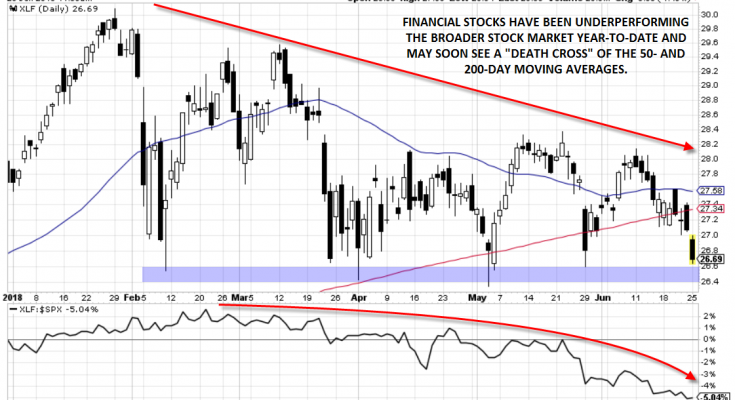Global equities are once again opening the week on the back foot as a joint story from the Wall Street Journal and Bloomberg further exacerbated US-China trade tensions. The report alleges that the US will increase scrutiny of Chinese investments in certain US industries deemed critical to economic and national security.
This morning, US Treasury Secretary Mnuchin tweeted that the report was “false, fake news†(the next mutation of the #fakenews epidemic?), but seemingly confirmed a very similar policy was in the works. Stock traders have opted to “sell first and ask questions later,†driving the Dow Jones Industrial Average down over 400 points midway through the trading day, with the tech-heavy Nasdaq Composite falling by more than 2.5% as of writing.
While today’s big drop in the market-leading technology sector is noteworthy, we wanted to take a close look at the second-largest US sector by market capitalization, financials. With interest rates generally rising through the first half of the year, a naïve analysis might suggest that financial stocks (which, after all, often make money by lending funds at the prevailing interest rate) should be big beneficiaries. In actuality, financials are among the worst-performing sectors year-to-date:

Source: Stockcharts.com, FOREX.com
The explanation for this counter-intuitive phenomenon lies with the yield curve or the difference between short- and long-term interest rates. While it’s true that interest rates have risen across the curve in the US, short-term rates have risen far more dramatically as the market adjusts to a more hawkish Federal Reserve. By contrast, longer-term interest rates, which vary based on the market’s expectation for long-term growth and inflation, have been relatively stationary.
The upshot is that the yield curve has flattened dramatically over the last 18 months. For example, the 2yr-10yr spread has fallen from about 130bps at the beginning of 2017 to 54bps at the beginning of 2018 to 34bps (0.34%) now. Banks and other financial institutions that make profits borrowing short-term funds (through products like savings accounts and CDs) and lending out funds over a longer-term horizon (through business, auto, and mortgage loans) may now expect their profits to fall. As a result, financial stocks continue to underperform the broader market.

